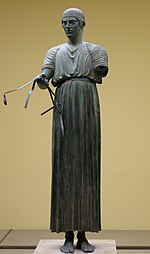Aesop
Aesop Αἴσωπος (Aisōpos) | |
|---|---|
 | |
| Born | c. 620 BC |
| Died | 564 BC (aged c. 56) Delphi, Greece |
| Nationality | Greek |
| Genre | Fable |
| Notable works | Number of fables now collectively known as Aesop's Fables |
Aesop or Æsop (Ancient Greek: Αἴσωπος, romanized: Aisōpos) is known for his fables. He was, by tradition, a slave of African descent who lived from about 620 BC to 560 BC in Ancient Greece.
Life
[change | change source]The tradition is that he was at one point freed from slavery and that he eventually died at the hands of Delphians. In fact, the doubt about his life has led some to deny his existence altogether.[source?]
Aesop's Fables
[change | change source]
Aesop's Fables or Aesopica refers to a collection of fables credited to Aesop. The Aesop's Fables has also become a blanket term for collections of brief fables, usually involving personified animals.
The most famous fable is a parable of the tortoise and the hare. In this story, a rabbit challenges a tortoise to a race. The rabbit is sure of its victory and as a result, depending on the version of the story, in some way completes the race slower than the turtle. Often, the hare takes a nap or takes too many breaks. The persistent tortoise, despite being slower, wins because it persevered.[source?]
No writings by him survive. Tales credited to him were gathered across the centuries and in many languages. This is a storytelling tradition that continues to the present day. Many of the tales have animals and inanimate objects that act like humans.
Influence
[change | change source]The Quranic figure Luqman (Arabic: لقمان) is often identified with Aesop, whose lore is found in several ancient cultures.[1][2][3] At some time during the Middle Ages, much was transferred to Luqman that was told in Europe of Aesop.[4] This identification with Aesop is confirmed by the fact that many of the fables ascribed to Aesop in the west are referred to Luqman in the east.[5]
The fables remain a popular choice for moral education of children today. Many stories included in Aesop's Fables, such as The Fox and the Grapes – from which the idiom "sour grapes" was derived, The Tortoise and the Hare (see Zeno's paradoxes) and The Shepherd Boy and the Wolf, also known as The Boy Who Cried Wolf, are well known throughout the world.
Aesop's Fables are still taught as moral lessons and used as subjects for entertainment, especially children's plays and cartoons. Aesop is said to have written thousands of fables, but none has been verified. This means we do not know whether he wrote any, or perhaps just collected them.
Related pages
[change | change source]Sources
[change | change source]- ↑ https://books.google.com/books?id=pMuxLlWih04C&dq=luqman+generally+identified+with+aesop&pg=PA70
- ↑ https://books.google.com/books?id=W3rjDAAAQBAJ&dq=luqman+aesop&pg=PT202
- ↑ https://books.google.com/books?id=NoqDBwAAQBAJ&dq=luqman+reference+to+aesop&pg=PA368
- ↑ https://books.google.com/books?id=jJY3AAAAIAAJ&dq=luqman+traditionally+aesop&pg=PA812
- ↑ https://books.google.com/books?id=Oc88AAAAIAAJ&dq=luqman+similar+to+aesop&pg=PR76
- Caxton, John, 1484. The history and fables of Aesop, Westminster. Modern reprint edited by Robert T. Lenaghan (Harvard University Press: Cambridge, 1967).
- Bentley, Richard, 1697. Dissertation upon the Epistles of Phalaris... and the Fables of Æsop. London.
- Jacobs, Joseph, 1889. The Fables of Aesop: Selected, Told Anew, and Their History Traced, as first printed by William Caxton, 1484, from his French translation
- i. A short history of the Aesopic fable
- ii. The Fables of Aesop
- Handford, S. A., 1954. Fables of Aesop. New York: Penguin.
- Perry, Ben E. (editor), 1965. Babrius and Phaedrus, (Loeb Classical Library) Cambridge: Harvard University Press, 1965. English translations of 143 Greek verse fables by Babrius, 126 Latin verse fables by Phaedrus, 328 Greek fables not extant in Babrius, and 128 Latin fables not extant in Phaedrus (including some medieval materials) for a total of 725 fables.
- Temple, Olivia and Robert (translators), 1998. Aesop, The Complete Fables, New York: Penguin Classics. (ISBN 0-14-044649-4)
Other websites
[change | change source]- Works by Aesop at Project Gutenberg
- Aesop's Fables Archived 2021-01-16 at the Wayback Machine
- Aesopica.net – Over 600 English fables, with Latin and Greek texts also – Searchable[permanent dead link]
- AesopFables.com – Large collection of fables, but many fables are NOT Aesopic
- Free audiobook of Aesop's Fables from LibriVox
- The Fables – A site primarily for children Archived 2007-02-10 at the Wayback Machine

